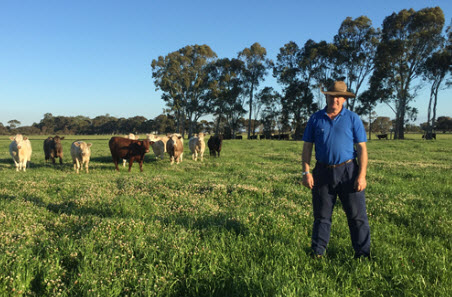No compromise on quality for WA MSA winners

An opportunistic cattle trading operation in WA’s south-west region has been recognised for making solid gains in eating quality performance of their cattle through the national Meat Standards Australia (MSA) program
Russell and Sonya Mead’s ‘Mills Farm Grazing’ enterprise received the state’s inaugural MSA Excellence in Eating Quality Progress Award, presented at Dunsborough in September.
The couple had the greatest improvement in compliance rates as represented by the MSA Index from the 1,679 registered producers in WA who consigned cattle to the program during 2015–17.
Chasing opportunities at the saleyard
Russell Mead said the award had come as a surprise and highlighted that running a commercially-focused cattle trading enterprise did not mean there was a need to compromise on turning-off high eating quality animals.
“Our strategy is to buy-in cattle of any type, age and breed when we see an opportunity to turn a profit from them,” he said.
“We don’t buy on type and we don’t buy ‘gold standard’, but we do seek those animals that show the best potential to put on weight and provide us with a good return on investment, given current seasonal conditions and market prices.
“This means we take a wide variety of animals and breed types, typically sourced at saleyards and comprising anything from older cows to young heifers and steers.”
The Meads run a grassfed grazing system at Benger and Coolup in WA’s high rainfall zone on predominantly clay, loam and sandy soil types.
Pastures are mainly clover and annual ryegrass-based, with some perennial kikuyu grass at Benger and annual average rainfall of about 750 millimetres.
Russell also operates a contract stock transport business that sees him regularly attending cattle sales across the south-west.
Strategies for value adding
“I’m always at the saleyards and tend to buy stock that catches my eye to add optimum value to my bottom line through opportunistic feeding,” he said.
The Meads tend to keep stock numbers low on both properties in autumn and winter to allow pastures to get going and to keep supplementary feeding costs low, as they buy in any necessary hay.
Peak cattle production is in spring when pasture growth takes off and they will feed and finish up to 160 head in total on both properties during this period.
The average time cattle spend on pasture is about seven months, although this varies widely according to stock type and condition. The target is to hit a minimum cattle live weight gain of one kg/head/day.
Russell and Sonya have been registered with MSA since the program started to ensure market access to processors with a requirement for MSA compliance.
“It is vital we participate in MSA to get the best returns possible from our stock enterprise,” he said.
Russell said their MSA results were improving in recent years most likely because they tend to feed cattle for longer to achieve turn-off dressed weights of about 250kg/head.
This is up from the long-term dressed weight average of 230kg/head, with the extra 20kg making a big difference to MSA Index performance.
“It was relatively easy to keep the stock on feed for longer in 2016, given good seasonal conditions, and it broadened our marketing opportunities by allowing us to sell when good prices came up at the processors or saleyards,” he said.
“We’ll adopt the same approach this year, although trading conditions have been more challenging given an unusually dry winter and cold spring – coupled with a recent cattle price contraction.
“We’ve also had to buy more heifers than steers this year due to availability, and it’s more difficult to control weight gain in that class of stock.”
Continuous improvement approach
Russell said although he was staggered at being recognised in the MSA awards for WA, it was very encouraging to be rewarded for his cattle management system that was not only driven by economics, but also incorporated good animal management practices and a desire to continue making improvements.
MSA Producer Engagement Officer Jarrod Lees said the Meads had increased their MSA Index from 52.32 in 2014–15, to 60.24 in 2015–17, and also increased their MSA compliance from 56% to 72%.
“The increase in compliance is testament to the finishing system that Russell uses,” Jarrod said.
“Ensuring cattle are gaining weight consistently will build up glycogen reserves in the animal to ensure good meat pH. Keeping animals on a consistent growth path will also help minimise ossification development, which contributes to improving the MSA Index.
“This is a good example of taking notice of carcase grading feedback and implement changes on farm where necessary.”
More information
To view the rest of the MSA Excellence in Eating Quality Award winners, visit mla.com.au/msaawards.



